Almost every personal plot and vegetable garden has flower beds with perennial flowers. One of the most popular flowering bushes is peonies. Although their flowering is short-lived, during this period they can leave incredible emotions on their owners. In order for a perennial bush to grow well, it is necessary to transplant peonies in the fall to another place, once every 3-5 seasons. In this way, it will be possible to maintain the plant in healthy condition.
Peonies are beautiful plants that are pleasing to the eye and can easily grow and bloom in one place for more than half a century. However, if they are constantly in one place, they may have difficulties. The bush may stop blooming. In this case, you need to transplant the bush into the most suitable soil. This needs to be done in the autumn.
This is justified by the fact that a successful wintering of a plant depends on the condition of its root system. If at the beginning of autumn, when the root system begins to accumulate all the nutrients, the bush is replanted, the likelihood that it will adapt to the new conditions and begin to bloom in the spring is very high. In addition, it is easier for a plant to adapt to a new place in cool times; a plant that has overwintered at the transplant site survives the summer heat well.
The bush will grow in a well-lit place, protected from drafts. If there is insufficient lighting, it may stop blooming. The flower loves the sun, but it cannot tolerate overheating. So the best place for bushes is away from fences and other objects that can give off their heat to peonies. If a gardener wants to transplant a bush into soil that is constantly moistened, due to the proximity of water sources, then he will not only not wait for the flower, but will also see how the peony rots.
Therefore, if it so happens that the planting site is characterized by the presence of underground water, it is best to make a high bed - this way the roots of the plant will not reach a destructive level.
Preparation of the bush
Before digging up a flower, you need to make sure that the planting site is prepared. A hole is dug quite large to accommodate prepared soil, mixed with humus, or purchased at the store.
- You need to dig up the bush carefully so as not to damage the roots too much.
- Do not touch the root system, that is, do not destroy the earthen lump formed around it.
- If you are unable to save the lump, remove all old and damaged roots.
- Trim the green stems, leaving about 10 - 15 centimeters from the root zone. That is, only sticks without leaves should stick out.
After completing all the steps, you can begin planting. There are no specific regulations or restrictions. You can act in any way you like. The bush is perfectly adapted to any growing conditions. Natural and climatic conditions do not affect its flowering and other life processes. Of course, we should not forget that decorative varieties of perennial flowers are more whimsical than simple ones.
How is the transplant performed?
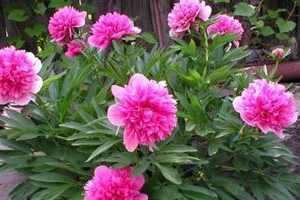 It is recommended to start digging holes for replanting peonies in the fall in the summer. Their diameter should be approximately eighty centimeters, depth - seventy. If it is necessary to transplant several bushes nearby, holes should be made at a distance of more than a meter from each other.
It is recommended to start digging holes for replanting peonies in the fall in the summer. Their diameter should be approximately eighty centimeters, depth - seventy. If it is necessary to transplant several bushes nearby, holes should be made at a distance of more than a meter from each other.
It is necessary to lay drainage in the finished hole. More than half of the hole (about two-thirds) needs to be filled with a soil mixture consisting of garden soil, humus and sand. It is worth fertilizing the soil a little and mixing it with drainage, and then watering it.
Before transplanting to another place, the prepared soil must be compacted. Before and after planting, you need to carefully monitor the acidity of the soil. In Kuban, transplanting peonies in the fall to another place is carried out in the same way as in other regions; you can watch videos of professional gardeners and see for yourself. Almost all flowers are unpretentious, especially if they are perennial.
- To transplant peonies, you need to cut their stems almost to the ground.
- Afterwards, the plant must be carefully dug up - it is recommended to carefully dig it from below, making a long trench.
- In order not to damage the root system of the plant, digging should be done at a distance of about thirty centimeters from the outer stems.
- For maximum convenience, it is recommended to remove the cut peony using a pitchfork. You should not pull the plant out of the ground by its stems - this can damage its roots and buds, which are located at its base and begin to develop for many years to come.
Having taken the bush out of the ground, you need to use a shovel to free its roots from excess soil. Next, the peony needs to be placed in a shady place for a couple of hours - during this time its roots will no longer be too brittle - and this is very important when replanting.
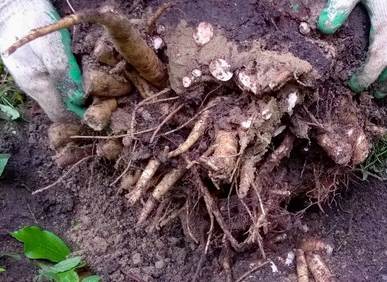

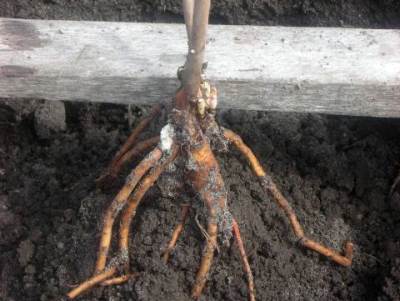
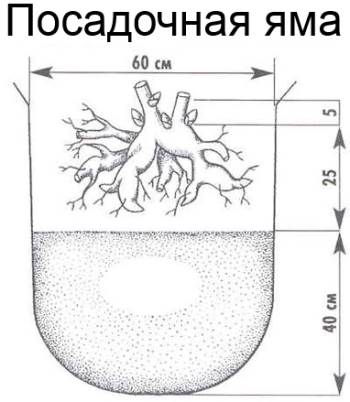
Since the peony has an extensive rhizome with many stems, the gardener can choose which one is suitable for planting. You need to choose young ones (they are painted light, in some places white) with a pair of shoots and several buds located on the roots. The selected parts must be carefully cut with a knife. Places, breaks and cuts should be immediately treated with wood ash or a solution of potassium permanganate.
The hole is filled with garden soil, compacted well and watered abundantly (however, it is important to ensure that the peony roots are not flooded).
Video:
Features of care
In order for the peony to grow quickly, it is important to ensure that the buds are covered with at least five centimeters of soil. If the peony is on heavy soil, then the layer of soil should be no more than four centimeters. This should be monitored throughout the life of the plant - its successful wintering and abundant flowering depend on it.
The transplanted plant should be watered regularly, in a volume that will provide the peony with a sufficient amount of nutrients, but will not destroy its root system. Here it is important to protect the root part of the bush from frost. IN in this case Mulch works great.
Since plants buried in the ground are located below the young roots, it is recommended to feed and fertilize the plant - best together with watering.
Immediately after transplanting peonies in the fall to another location, it is recommended to begin preparing the plant for winter. Towards the end of October, all shoots need to be cut off at the root and the soil should be thoroughly loosened, after watering it well. Since autumn is a fairly rainy season, there is no need to water the plant. If the weather is warm, dry, the plant still needs watering.
Pruning a bush in spring
In the first spring of a peony in a new place, it is recommended to cut off all the flowers - the bush has not yet matured in the new place; if you get rid of all the buds, all the nutrients received by the plant will be used for the formation and development of roots, due to which next year the flowering will last longer, and the buds will be larger.
 Undoubtedly, peony is a very capricious plant, which is why, when it finds itself in a new place, it may refuse to bloom. In order to cope with this problem and again begin to admire the indescribable beauty of the flower, it is necessary to find the source of this behavior.
Undoubtedly, peony is a very capricious plant, which is why, when it finds itself in a new place, it may refuse to bloom. In order to cope with this problem and again begin to admire the indescribable beauty of the flower, it is necessary to find the source of this behavior.
As mentioned above, the peony bush is very demanding on lighting. If the gardener is not completely sure whether the flower will be comfortable in a new place, it is better not to take risks.
The first year in a new place is the most difficult for a flower. That is why, in order to help the flower quickly settle in and grow, it is recommended to fertilize the plant abundantly. It is not necessary to buy expensive products - ordinary manure will do (you need to water the plant with its rotted solution).
One of the most common reasons for a peony to fail to bloom is an incorrect planting level. If the plant is too buried in the ground, it is worth digging it up and planting it correctly; with the opposite problem, hilling will help.
Providing mineral components and fertilizers
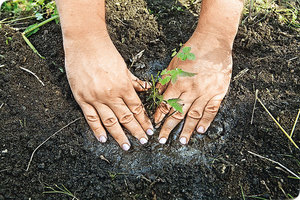 Lack of food is the most obvious reason for a flower not blooming. In the first year, when the root system of the plant has not yet become stronger, and the peony itself has not had time to adapt to the new place, it is important to give it a sufficient amount of fertilizer - with its help, the plant will quickly get used to the new place, grow roots and adapt.
Lack of food is the most obvious reason for a flower not blooming. In the first year, when the root system of the plant has not yet become stronger, and the peony itself has not had time to adapt to the new place, it is important to give it a sufficient amount of fertilizer - with its help, the plant will quickly get used to the new place, grow roots and adapt.
The timing of transplanting peonies to another location in the fall is also important.
Caring for any plant is based on the use of high-quality mineral fertilizers and humus. That is, you need to be able to create the right set of components that can really help peonies. Humus is placed at a shallow depth during planting, or mixed with the soil. Mineral fertilizers are applied in spring or summer, depending on the condition of the flower.
Incorrect and untimely pruning of leaves can also cause the peony to not show off its buds. When cutting buds (it does not matter how many years the plant has been growing in one place), it is strictly forbidden to cut off the leaves from the stem. In the first year of flowering, you can leave the bush without all the buds; in subsequent years, it is recommended to cut off no more than a third. It is not recommended to trim the leafy part of the plant before the first frost.
Pest protection
One of the common diseases of peony is rust. Small bugs attack peony buds, sucking the juice out of them, thereby depriving the gardener of flowering.
At the end of autumn, during the onset of frost, the stems of peonies should be cut down to the ground, the stems should be removed and the soil should be watered abundantly. Transplanting roses to another place in the fall in the Moscow region is no different from other regions. Follow the recommendations strictly and you will be able to achieve maximum results.
If the peony is already many years old and seems hopeless, do not despair. The situation can be corrected by transplanting it to a new place in the fall. After it, the probability that the plant will bloom again is very high.
TRANSPLANTING PEONIES - HOW AND WHEN TO TRANSPLANT PEONIES
TREE PEONY
Mid-August is the best time in the middle zone for dividing, planting and transplanting peonies to a new location. Gardeners who did not replant because they did not know how and when to replant peonies will gain a lot of useful information from this article.
Choosing a landing site
Peonies can survive without replanting for several decades, so choose a location carefully.
Peonies love the sun and tolerate some shade. Places near buildings are not suitable for them - the plants suffer from overheating. Near tall trees and bushes they may lack water and nutrition.
A peony can be planted at least a meter from an adult tree (but not under the crown!), if the tree is located in the north or south. The sun, passing across the sky from east to west, illuminates the bush and it develops well.
Bushes that receive direct sunlight only in the afternoon will not produce high-quality cuttings, since the peduncles and flowers themselves will be deformed. Bushes illuminated during the day, on the contrary, have straight peduncles and bloom profusely. Their flowers have a typical shape and color for the variety.
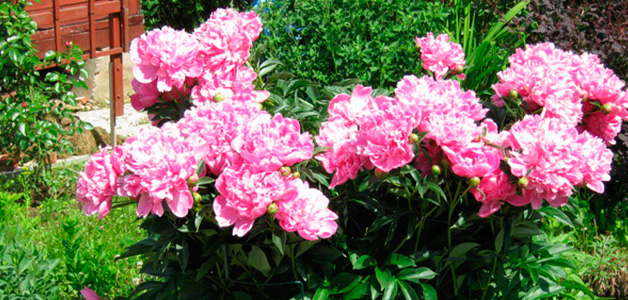
Pit preparation
Transplanting peonies in summer begins with preparing a planting hole. The pit needs to be prepared a month before planting so that the soil has time to settle. If the soil settles after planting peonies, this will adversely affect their condition.
The roots of peonies grow greatly in depth and width, so dig a spacious planting hole that they can completely occupy over time. If the hole is shallow, the roots will stop growing as soon as they reach a solid horizon, and without a developed root system, the peony will not be able to express itself in all its beauty.
The optimal pit size is 70x70 cm (diameter and depth). Pieces of broken bricks are placed at the bottom of the planting pit or a bucket of sand is poured out. A nutrient substrate is prepared based on the soil extracted from the pit, adding 2 liters of humus or peat, 200 g of phosphorus fertilizer and 300 g of ash. Higher doses of fertilizer will lead to excessive leaf development and reduced flowering.

The substrate is mixed and spilled with water. Then the pit and the substrate lying nearby are left to settle and rest. We will have to return to them only in a month, in mid-August-September, when the time comes to plant peonies.
What if the soil water is not far from the surface? Peonies do not like stagnant water, but there is no need to give up planting them.
You can get out of this situation if you plant the plants very shallowly. The hole is made only 10 cm deep, but larger in diameter than usual - about a meter. Drainage is poured onto the bottom, then the substrate (the same as described above). The peony roots are kept in a clay mash for 30 minutes, then a division is placed on top of the substrate and the roots are sprinkled with it. The top of the planting hole is covered with pieces of turf.
What is a standard division
A delenka is a standard planting unit for peonies. It is a piece of rhizome with 3-5 buds and 2-3 roots. A bush grown from such a cutting begins to bloom luxuriously in the third year, and the first flowers will appear in the second year. Divisions with fewer buds are considered non-standard and have to be raised in school (we will talk about this in more detail below).
You cannot plant cuttings with 6 or more buds, since the plant develops not by forming new roots, but by consuming nutrients from the old rhizome. Such a plant produces many buds, and it looks lush in appearance, but produces few flower stalks. In the future, its development stops altogether and the plant may die in the third year.

Dividing adult bushes requires certain skills. Bushes older than five years form a massive and intricate root system, the intricacies of which can be difficult to understand. When dividing, the rule must be observed: the more buds there are on the division, the more roots there should be on it.
How to divide an old peony bush
Inspect the bush and select the cutting lines, determining with which adventitious roots each part of the rhizome will remain after division. In this case, you can try to loosen the rhizome with your hands until bend lines appear - along such lines it will be more convenient to cut the bush. After 1-2 cuts the situation becomes clearer and even a tangled rhizome can be successfully divided into standard sections.
The rhizome is cut with a chisel or chisel, tapping it with a wooden hammer.
Pieces of rhizome are loosened by hand, separating the intertwined roots.
The cuttings are washed from the remaining soil, weak, rotten and upward-growing roots are cut out.
The remaining roots are cut with a garden knife, leaving 15 cm of their length. The cuts should be as smooth as possible.
The cuttings are treated for several hours from root rot in a solution of potassium permanganate (2 g per 5 liters). A more concentrated solution will burn the kidneys. Instead of potassium permanganate, you can use a solution of vitriol (50 g per 5 liters), keeping the plant in it for no more than 20 minutes. Exceeding this time leads to burns and death of the cuttings.
Many people prefer non-chemical disinfection, for which you can use garlic tincture. 200 g of peeled slices are twisted through a meat grinder, poured with a liter of water and left for 3 days. The tincture is filtered and stored in the refrigerator in a tight container for no more than three months. To process peonies, add 4 tbsp to a liter of water. tinctures and keep them for half an hour.
After etching, all sections are sprinkled with powdered charcoal or a 1:1 mixture of charcoal and colloidal sulfur.
The planting material is placed in the shade for 24 hours so that a protective cork layer forms on the cuts.
The delenki are dipped into a clay mash, to which a heteroauxin tablet and a little wood ash are added. The mixture should have a paste-like consistency.
The pieces removed from the chatterbox are laid out to dry. After this they can be stored for a long time. In this condition they can be sent by mail. After 5 hours, the rhizomes treated with mash can be planted in a permanent place or temporarily buried until the peonies are replanted in the fall.
Growing peonies in school. Small divisions can be raised for several years in a school, where they will reach standard sizes. A school is a garden bed with well-prepared, fertile soil. Sections of rhizomes are planted in a shrub according to a 20x20 cm pattern, buried in the soil. The layer of soil above the buds should be about 3 cm. For the winter, the plantings are covered with compost. In a year or two they can be planted in a permanent place.
Planting peonies
The main condition for successful planting of peonies is that after all the manipulations associated with planting, the buds should be at a depth of 5 cm. If this condition is not met, the plant will form few generative shoots, that is, it will not bloom profusely.
To prevent soil subsidence after planting and to prevent the buds from being “dragged” to excessive depth, you need to plant as follows:
Water is poured into the planting hole and the cutting is lowered into it, holding it at the required distance from the soil surface.
The nutrient substrate is poured into water until the cutting is lying on it. Then the remaining substrate is filled in.

With this method of planting, the buds are guaranteed to be at the required depth.
When planting several peonies, they are placed a meter apart from each other. The soil should not be dry in the first few weeks after planting, while the plants take root. If the weather is dry in August and September, then after a while the peonies need to be watered.
How to replant peonies correctly
If it is not planting that is required, but replanting the peony to a new place, then it is simply dug up with a lump of earth and replanted. Such plants take root without problems and bloom as usual.
Sometimes the question arises: can flowering peonies be replanted or is it better to wait. The flowering period of peonies is short, the bush blooms for only 2-3 weeks, so you should wait until the end of flowering and then replant the plant by digging it up along with a lump of earth.
If you need to replant a young but already blooming peony, you need to take into account that replanting it to another place will prevent new buds from blooming and this year the plant will not look as decorative as always.

Typical mistakes when planting peonies
If a peony does not bloom for a long time after planting or does not develop well, then this means that something does not suit it. Here are a few mistakes that gardeners most often make when planting peonies:
Wrong choice of location. Bushes should not be located in the root growth zone of large trees or in the shade. To bloom profusely, they need a minimum of 5 hours of direct light, ideally early in the day.
Incorrect planting depth. Buried bushes need to be raised and soil added under them. If the planting, on the contrary, is too shallow, then the buds freeze slightly every year. To correct the situation, you need to replant the peony bush deeper, having first completely dug it out.
Excessive amount of humus in the planting hole.
Too acidic soil. Peonies prefer soil with a neutral solution reaction and develop poorly in areas with acidic soil.
Pieces too large or small.
Replanting peonies - when is it better to do it, in summer or autumn? If you plant or replant peonies in August, they will take root and have time to take root well before winter. In due time, they will delight the owner with numerous and large flowers. Peonies planted in September will need an additional year to adapt.
ADVICE FROM LYUDMILA...
HERBAL PEONIES ARE BETTER TO PLANT IN THE SUN. IT IS PEONIES GROW BETTER IN THE SUN. BUT THEY WILL ALSO CORRECT WITH partial shade.. TREE PEONIES SHOULD BE PLANTED IN partial shade. PLEX FERTILIZERS TYPE FERTIKA.in spring RAKE THE EARTH WELL FROM THE ROOTS AND SPIN HALF A CUP OF BONE, FISH AND BLOOD MEAL.. In the fall, you can add bone and fish meal to the planting hole. Blood meal only in the spring..
Or in May. Dig up the bush, trying to capture as much soil as possible on the roots. Prepare a hole in the area, preferably a small one. Add nutritious, loose soil there. At the same time, avoid adding fresh organic matter; it is better to use rotted compost, manure or complete mineral fertilizer.
In summer, keep an especially close eye on peonies. Cut off the first buds that appear after transplantation. And water the bushes daily.
If the plant does not take root well in a new place, choose another planting place for them towards the end of summer.
The roots of the flower may break off when you dig up the bush for replanting, since they are very fragile in the spring. Collect cuttings and fragments of roots and plant them in a bed of loose, nutritious soil, so you will get additional bushes in the future.
Take charcoal, crush it and process the sections of broken roots. In August, you can carefully transplant them to another, more convenient bed, not forgetting to water regularly.
But it is best to replant peonies in the fall. The place on the site where you will transfer the flower should be sunny and open. It is undesirable to be close to groundwater to prevent rotting of the roots.
Prepare the planting site 3-4 weeks before starting work. Dig a hole, fill it 2/3 with a mixture of peat, humus, sand and garden soil taken in equal parts. Add 220 g of double superphosphate, a can of wood ash and a tablespoon of iron sulfate.
The peony rhizome is dug up very carefully. Since the roots penetrate the ground to a depth of 0.5-1 meters, this will have to be done for a long time. Do not use a shovel, it is better to take a pitchfork and dig the rhizome in a circle, then pull it out of the ground, holding it on both sides with shovels. Leave the plant in the shade for 2-3 hours to avoid root breakage.
Now you need to divide the peony to get a division and a part of the rhizome measuring about 10-15 cm. Remove small and rotten sections of the root. It is better to do this with a knife or a sharp wooden wedge. Start by dividing into 2-3 parts, and then smaller. Before planting, the divisions can be placed in a container with a saturated solution of potassium permanganate to disinfect.
Plant the bush in the prepared hole, sprinkle the top with soil taken from the garden. Make sure that the layer is no more than 5 cm, and then water well. Remember that a young plant needs to be looked after regularly, constantly watered, loosened the soil, removed buds, weeded, sprayed for pests, etc. In the second year of life, peonies bloom rarely, delighting with an abundance of inflorescences a few more seasons later, in the summer.
Not many novice gardeners know when to replant peonies and when to do it. It is better to move a flower from one place to another without disturbing the root system, unless, of course, this is dividing the bush. Separation of roots and transshipment in spring and autumn follows the rules, so carefully read the step-by-step guide to minimize trauma to your beautiful plants...
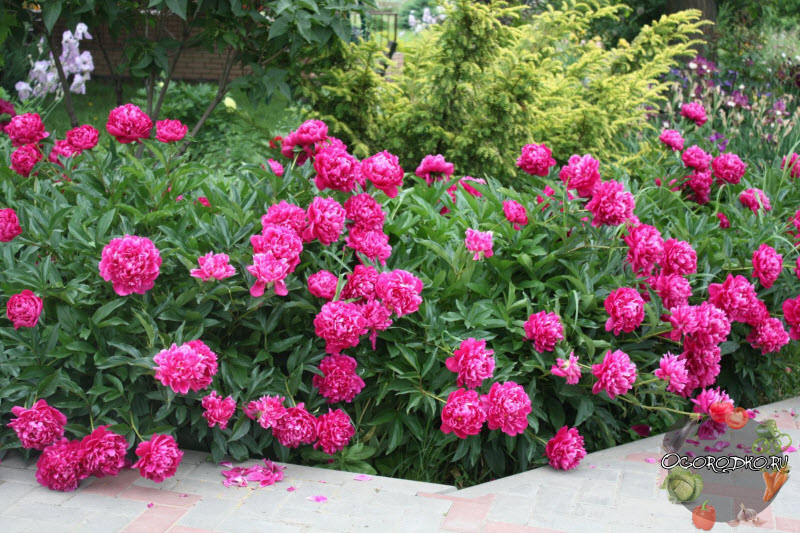
Transplanting peonies in the fall - terms and rules
Peonies are replanted for several reasons - the plant has stopped blooming or the color has faded, you want to increase the number of your favorite flowers, or for some reason you urgently need to change the place of residence of the bush. When to replant peonies is the gardener’s choice, but it is best to move in August-October: the bush has already faded, the heat has subsided, and the autumn rains are still far away. The flower will have time to adapt to its new place of residence before winter, and by the time of growth and vegetation, the roots will have become stronger, and all the energy of the large flower will be directed towards growth.
Why before the rainy season? So that the cut roots do not absorb a lot of moisture and simply rot. For different regions, transplantation times differ:
- Transplanting peonies in the fall in the Moscow region, in the North-West and in the Middle Zone begins on August 20 and continues until September 25
- Ukraine and southern Russia - from September 1 to September 30; in dry weather, replanting peonies in the fall can be extended until October
- Siberia and the Urals - from August 20 to September 20
In principle, the operation of replanting peonies after flowering can be performed at any time of the year, but it is better in the fall, so that the plant has time to adapt for the winter after moving - this best option. In any case, the process begins with choosing a location and digging a hole. The future location of the flower garden should not be in the shade, because flowers love light, and should be located away from the walls that block the sun and screen heat from the flower beds.
Is it possible to replant peonies in the spring?
Peonies are flowers that can grow in one place for up to 50 years; these large flowers do not like frequent transplants, especially in spring. Experienced gardeners strongly recommend carrying out any moving manipulations in the fall, with the exception of replanting peonies by transferring a (young) bush with a lump of earth. But circumstances are different.
When replanting peonies in spring, the rule applies - the sooner, the better. Therefore, the process should begin as soon as the snow melts. Flooding of the soil by melted snow can also be a good reason for changing the location of the bush.
- Planting begins before the beginning of the growing season, otherwise it is easy to disrupt the root system during transplantation
- Peonies transplanted from one place to another in the spring are stunted in growth
- With proper planting and proper care, the survival rate of the plant is quite high.
- It is strictly not recommended to divide peonies in the spring, just move the large flowers to another place
Rules for replanting a bush
Grown bushes will need a lot of space; it is advisable to dig holes for planting at a distance of 1-1.5 meters. Since peonies need to be planted to a depth of no more than 5-8 cm (more - the bush will take a long time to sprout, less - they will freeze in winter), a large hole is not required: 15 cm in depth, 40 in diameter is enough. Fertilizer is placed at the bottom of the prepared pit - humus, manure, and other organic matter. To add looseness, you can add sand; if the soil is sufficiently ventilated, this step will be unnecessary. Transfer the divided and disinfected bush and dig it in, forming a hill 10 cm high. Water the bush generously, and if desired, mulch the plant with peat or humus.
To transplant peonies in the fall to another place, you need to trim the bushes, leaving about 20 cm of branches and digging them within a radius of 20 cm. In order not to damage the rhizomes of peonies during transplantation, it is better to dig up the flower with a pitchfork. Dig up the bush so that the root system can easily come out of the ground. The roots are washed, broken and rotten ones are trimmed, and they are treated with a weak solution of potassium permanganate. To make the root system more resilient, it is recommended to place the plant in the shade for a couple of hours. The weathered root is not so fragile. Now you can start moving. It is worth noting that replanting does not depend on what varieties of peonies you want to move on the site, with the exception of.
If the plant is 4 years old and needs to be propagated, it’s time to replant the peonies after flowering to separate the roots. After the root system has been removed and cleared of soil, inspect it. Specimens with six or more buds are suitable for division, since at least 3 buds must be left on the separated cut part. We dry the root, cut it with a disinfected knife, treat it with a light solution of manganese and begin planting. By spring, large flowers will get stronger and can please you with flowers. Knowledgeable gardeners recommend cutting off the first flower so that the plant takes root better, and in the second year enjoy abundant flowering.
Peonies are beautiful flowers that do not require special care, but proper planting will help the plant recover faster and begin to bloom. Experienced flower growers recommend adhering to several simple rules:
- During spring transplantation, the air temperature outside should reach +10 °C, and the ground should warm up to +3 °C - it is at this temperature that the growth and formation of the roots of the bush begins
- Flowers are unpretentious to the soil - in soil with sand the bush will bloom faster, but will quickly lose its decorative effect, in clay soil appearance the peony will please longer, but flowering will occur with a delay
- After transplantation, the plant requires careful attention for a year until it gets stronger.
- When choosing a new site, pay attention to bright, draft-free places - shade can stop flowering
- Avoid excessive watering, especially after dividing the roots - the bush quickly gains moisture and may rot
- For the same reason, when choosing a place, pay attention so that melt and rain water does not flow towards the bushes
- During transplantation, be sure to feed the plant and make drainage in the hole
In a new place at proper care The bush blooms in 2-3 years. If there is no flowering, the soil may be low in moisture and nutrients. To correct the situation, feed the flower. This may be caused by incorrect planting depth or poor shelter of the bush for the winter, or lack of light in the area. The situation can be corrected with an additional transplant.
When to replant peonies? The choice depends on the desires of the gardener and the circumstances. Follow these simple recommendations to get the lush color of this unpretentious perennial shrub.
TREE PEONY
Mid-August is the best time in the middle zone for dividing, planting and transplanting peonies to a new place. Gardeners who did not replant because they did not know how and when to replant peonies will gain a lot of useful information from this article.
Choosing a landing site
Peonies can survive without replanting for several decades, so choose a location carefully.
Peonies love the sun and tolerate some shade. Places near buildings are not suitable for them - the plants suffer from overheating. Near tall trees and bushes they may lack water and nutrition.
A peony can be planted at least a meter from an adult tree (but not under the crown!), if the tree is located in the north or south. The sun, passing across the sky from east to west, illuminates the bush and it develops well.
Bushes that receive direct sunlight only in the afternoon will not produce high-quality cuttings, since the peduncles and flowers themselves will be deformed. Bushes illuminated during the day, on the contrary, have straight peduncles and bloom profusely. Their flowers have a typical shape and color for the variety.
Pit preparation
Transplanting peonies in summer begins with preparing a planting hole. The pit needs to be prepared a month before planting so that the soil has time to settle. If the soil settles after planting peonies, this will adversely affect their condition.
The roots of peonies grow greatly in depth and width, so dig a spacious planting hole that they can completely occupy over time. If the hole is shallow, the roots will stop growing as soon as they reach a solid horizon, and without a developed root system, the peony will not be able to express itself in all its beauty.
The optimal pit size is 70x70 cm (diameter and depth). Pieces of broken bricks are placed at the bottom of the planting pit or a bucket of sand is poured out. A nutrient substrate is prepared based on the soil extracted from the pit, adding 2 liters of humus or peat, 200 g of phosphorus fertilizer and 300 g of ash. Higher doses of fertilizer will lead to excessive leaf development and reduced flowering.
The substrate is mixed and spilled with water. Then the pit and the substrate lying nearby are left to settle and rest. We will have to return to them only in a month, in mid-August-September, when the time comes to plant peonies.
What if the soil water is not far from the surface? Peonies do not like stagnant water, but there is no need to give up planting them.
You can get out of this situation if you plant the plants very shallowly. The pit is made only 10 cm deep, but larger in diameter than usual - about a meter. Drainage is poured onto the bottom, then the substrate (the same as described above). The peony roots are kept in a clay mash for 30 minutes, then a division is placed on top of the substrate and the roots are sprinkled with it. The top of the planting hole is covered with pieces of turf.
What is a standard division
A delenka is a standard planting unit for peonies. It is a piece of rhizome with 3-5 buds and 2-3 roots. A bush grown from such a cutting begins to bloom luxuriously in the third year, and the first flowers will appear in the second year. Divisions with fewer buds are considered non-standard and have to be raised in school (we will talk about this in more detail below).
You cannot plant cuttings with 6 or more buds, since the plant develops not by forming new roots, but by consuming nutrients from the old rhizome. Such a plant produces many buds, and it looks lush in appearance, but produces few flower stalks. In the future, its development stops altogether and the plant may die in the third year.
Dividing adult bushes requires certain skills. Bushes older than five years form a massive and intricate root system, the intricacies of which can be difficult to understand. When dividing, the rule must be observed: the more buds there are on the division, the more roots there should be on it.
How to divide an old peony bush
- Inspect the bush and select the cutting lines, determining with which adventitious roots each part of the rhizome will remain after division. In this case, you can try to loosen the rhizome with your hands until inflection lines appear - along such lines it will be more convenient to cut the bush. After 1-2 cuts the situation becomes clearer and even a tangled rhizome can be successfully divided into standard sections.
- The rhizome is cut with a chisel or chisel, tapping it with a wooden hammer.
- Pieces of rhizome are loosened by hand, separating the intertwined roots.
- The cuttings are washed from the remaining soil, weak, rotten and upward-growing roots are cut out.
- The remaining roots are cut with a garden knife, leaving 15 cm of their length. The cuts should be as smooth as possible.
- The cuttings are treated for several hours from root rot in a solution of potassium permanganate (2 g per 5 liters). A more concentrated solution will burn the kidneys. Instead of potassium permanganate, you can use a solution of vitriol (50 g per 5 liters), keeping the plant in it for no more than 20 minutes. Exceeding this time leads to burns and death of the cuttings.
- Many people prefer non-chemical disinfection, for which you can use garlic tincture. 200 g of peeled slices are twisted through a meat grinder, poured with a liter of water and left for 3 days. The tincture is filtered and stored in the refrigerator in a tight container for no more than three months. To process peonies, add 4 tbsp to a liter of water. tinctures and keep them for half an hour.
- After etching, all sections are sprinkled with powdered charcoal or a 1:1 mixture of charcoal and colloidal sulfur.
- The planting material is placed in the shade for 24 hours so that a protective cork layer forms on the cuts.
- The delenki are dipped into a clay mash, to which a heteroauxin tablet and a little wood ash are added. The mixture should have a paste-like consistency.
- The pieces removed from the chatterbox are laid out to dry. After this they can be stored for a long time. In this condition they can be sent by mail. After 5 hours, the rhizomes treated with mash can be planted in a permanent place or temporarily buried until the peonies are replanted in the fall.
Growing peonies in school. Small divisions can be raised for several years in a school, where they will reach standard sizes. A school is a garden bed with well-prepared, fertile soil. Sections of rhizomes are planted in a shrub according to a 20x20 cm pattern, buried in the soil. The layer of soil above the buds should be about 3 cm. For the winter, the plantings are covered with compost. In a year or two they can be planted in a permanent place.
Planting peonies
The main condition for successful planting of peonies is that after all the manipulations associated with planting, the buds should be at a depth of 5 cm. If this condition is not met, the plant will form few generative shoots, that is, it will not bloom profusely.
To prevent soil subsidence after planting and to prevent the buds from being “dragged” to excessive depth, you need to plant as follows:
- Water is poured into the planting hole and the cutting is lowered into it, holding it at the required distance from the soil surface.
- The nutrient substrate is poured into water until the cutting is lying on it. Then the remaining substrate is filled in.
With this method of planting, the buds are guaranteed to be at the required depth.
When planting several peonies, they are placed a meter apart from each other. The soil should not be dry in the first few weeks after planting, while the plants take root. If the weather is dry in August and September, then after a while the peonies need to be watered.
If it is not planting that is required, but replanting the peony to a new place, then it is simply dug up with a lump of earth and replanted. Such plants take root without problems and bloom as usual.
Sometimes the question arises: can flowering peonies be replanted or is it better to wait. The flowering period of peonies is short, the bush blooms for only 2-3 weeks, so you should wait until the end of flowering and then replant the plant by digging it up along with a lump of earth.
If you need to replant a young but already blooming peony, you need to take into account that replanting it to another place will prevent new buds from blooming and this year the plant will not look as decorative as always.
Typical mistakes when planting peonies
If a peony does not bloom for a long time after planting or does not develop well, then this means that something does not suit it. Here are a few mistakes that gardeners most often make when planting peonies:
- Wrong choice of location. Bushes should not be located in the root growth zone of large trees or in the shade. To bloom profusely, they need a minimum of 5 hours of direct light, ideally early in the day.
- Incorrect planting depth. Buried bushes need to be raised and soil added under them. If the planting, on the contrary, is too shallow, then the buds freeze slightly every year. To correct the situation, you need to replant the peony bush deeper, having first completely dug it out.
- Excessive amount of humus in the planting hole.
- Too acidic soil. Peonies prefer soil with a neutral solution reaction and develop poorly in areas with acidic soil.
- Pieces too large or small.
Replanting peonies - when is it better to do it, in summer or autumn? If you plant or replant peonies in August, they will take root and have time to take root well before winter. In due time, they will delight the owner with numerous and large flowers. Peonies planted in September will need an additional year to adapt.
ADVICE FROM LYUDMILA...
HERBAL PEONIES ARE BETTER TO PLANT IN THE SUN. IT IS PEONIES GROW BETTER IN THE SUN. BUT THEY WILL ALSO CORRECT WITH partial shade.. TREE PEONIES SHOULD BE PLANTED IN partial shade. PLEX FERTILIZERS TYPE FERTIKA.in spring RAKE THE EARTH WELL FROM THE ROOTS AND SPIN HALF A CUP OF BONE, FISH AND BLOOD MEAL.. In the fall, you can add bone and fish meal to the planting hole. Blood meal only in the spring..



